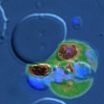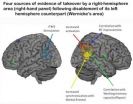(Press-News.org) PHILADELPHIA - One of the most insidious ways that parasitic diseases such as malaria and toxoplasmosis wreak their havoc is by hijacking their host's natural cellular processes, turning self against self. Researchers from the Perelman School of Medicine, University of Pennsylvania and Johns Hopkins University, led by Doron Greenbaum, Ph.D., assistant professor of Pharmacology at Penn, have identified the cell signaling pathway used by these parasites to escape from and destroy their host cells and infect new cells -- pointing the way toward possible new strategies to stop these diseases in their tracks. The study appears in Cell, Host and Microbe.
When the Plasmodium falciparum and Toxoplasma gondii parasites invade a host cell, they take up residence inside a "parasitophorous vacuole" (PV), growing and replicating themselves for about 48 hours. Then they burst out of the PV, completely destroying and dissolving the protein-based cytoskeleton of their host, freeing themselves to seek out and infect new host cells. Greenbaum's previous work showed that both P. falciparum and T. gondii hijack the calcium-regulated enzyme calpain from host cells and use it to break down host cytoskeleton. The current Cell, Host and Microbe study took the next step of identifying which host signaling pathway was involved, with the aim of derailing the parasite's escape route, trapping it inside the host cell and preventing it from spreading infection.
"We found an entire signaling pathway in the human host cell that the parasite engages, starting from a G-protein-coupled receptor, that the parasite uses to dismantle the cytoskeleton of the host cell, causing it to collapse," Greenbaum explains.
"There's a complex series of proteins in this signaling cascade. One of the key proteins is protein kinase C [PKC]. We found a tremendous amount of biological validation for the existence and use of this pathway in both parasitic organisms."
Independent of calpain, the researchers also found that host PKC played an important role in the loss of protein adducin from the host cytoskeleton, contributing greatly to its collapse.
To test the role of the PKC signaling cascade in the disease process, Greenbaum and his collaborators tested known PKC inhibitors in both cell assays and in mouse models. These studies showed a marked decrease in parasitic infection for both P. falciparum and T. gondii. Greenbaum notes, "It's a human enzyme [PKC] that we're targeting, and by inhibiting it we've basically blocked the parasites from getting out. They're trapped and die within the host cells." A key advantage of such an approach, explains Greenbaum, is that "targeting a host protein will engender less resistance because the parasite has no genetic control over the host."
One of the inhibitors tested was a new orally available agent called sotrastaurin, a PKC inhibitor. This drug has already passed Phase I trials and is currently undergoing Phase II trials for various indications. In the mouse studies, sotrastaurin administration also resulted in a significant decrease in parasitemia and markedly increased survival rates against Plasmodium berghei ANKA, thus showing great potential as an oral antimalarial.
"We've piggybacked this line of research onto a drug class that's already vetted," says Greenbaum. "We're quite excited about that. We've found a compound that's already been used in trials in humans and is deemed safe."
Greenbaum and his team are hopeful that after more extensive animal testing, the next step could be human trials of sotrastaurin against malaria. This compound, or similar PKC inhibitors, could provide a multipronged weapon against malaria and other parasitic disease.
"This approach could be used as both a prophylactic and a treatment," Greenbaum says. "We have some indication that it could also used to block transmission."
INFORMATION:
The research was funded by the Penn Genome Frontiers Research Institute, the Penn TAPITMAT Pilot Program, and the National Institutes of Health (NIHT32AI007532; 1R01AI097273-01A1; R01 AI056840).
Co-authors are Melanie G. Millholland, Christopher D. Dupont, Melissa S. Love, Bhumit Patel, Dustin Shilling, Marcelo G. Kazanietz, J. Kevin Foskett, and Christopher A.
Hunter, all from Penn; and Photini Sinnis and Satish Mishra, from Hopkins.
Penn Medicine is one of the world's leading academic medical centers, dedicated to the related missions of medical education, biomedical research, and excellence in patient care. Penn Medicine consists of the Raymond and Ruth Perelman School of Medicine at the University of Pennsylvania (founded in 1765 as the nation's first medical school) and the University of Pennsylvania Health System, which together form a $4.3 billion enterprise.
The Perelman School of Medicine is currently ranked #2 in U.S. News & World Report's survey of research-oriented medical schools. The School is consistently among the nation's top recipients of funding from the National Institutes of Health, with $479.3 million awarded in the 2011 fiscal year.
The University of Pennsylvania Health System's patient care facilities include: The Hospital of the University of Pennsylvania -- recognized as one of the nation's top "Honor Roll" hospitals by U.S. News & World Report; Penn Presbyterian Medical Center; and Pennsylvania Hospital — the nation's first hospital, founded in 1751. Penn Medicine also includes additional patient care facilities and services throughout the Philadelphia region.
Penn Medicine is committed to improving lives and health through a variety of community-based programs and activities. In fiscal year 2011, Penn Medicine provided $854 million to benefit our community.
Trapping malaria parasites inside host cell basis for new drugs
2013-01-16
ELSE PRESS RELEASES FROM THIS DATE:
Light from the darkness
2013-01-16
On the left of this new image there is a dark column resembling a cloud of smoke. To the right shines a small group of brilliant stars. At first glance these two features could not be more different, but they are in fact closely linked. The cloud contains huge amounts of cool cosmic dust and is a nursery where new stars are being born. It is likely that the Sun formed in a similar star formation region more than four billion years ago.
This cloud is known as Lupus 3 and it lies about 600 light-years from Earth in the constellation of Scorpius (The Scorpion). The section ...
New Carnegie Mellon research reveals exactly how the human brain adapts to injury
2013-01-16
PITTSBURGH—For the first time, scientists at Carnegie Mellon University's Center for Cognitive Brain Imaging (CCBI) have used a new combination of neural imaging methods to discover exactly how the human brain adapts to injury. The research, published in Cerebral Cortex, shows that when one brain area loses functionality, a "back-up" team of secondary brain areas immediately activates, replacing not only the unavailable area but also its confederates.
"The human brain has a remarkable ability to adapt to various types of trauma, such as traumatic brain injury and stroke, ...
Study examines link between incarceration and psychiatric disorders
2013-01-16
WASHINGTON, DC, January 16, 2013 — Psychiatric disorders are prevalent among current and former inmates of correctional institutions, but what has been less clear is whether incarceration causes these disorders or, alternatively, whether inmates have these problems before they enter prison. A study co-authored by Jason Schnittker, an associate professor of sociology at the University of Pennsylvania, shows that many of the most common psychiatric disorders found among former inmates, including impulse control disorders, emerge in childhood and adolescence and, therefore, ...
Vaccination responsible for dramatic fall in Salmonella infections
2013-01-16
Mass poultry vaccination programmes introduced to combat Salmonella infections have led to a dramatic fall in the number of cases since the late 1990s, according to a researcher at the University of Liverpool.
Salmonella are important food-borne pathogens worldwide, causing diarrhoea, vomiting, nausea, fever and abdominal pain. There are currently around 6 million cases of illness from Salmonella across the EU each year, the majority of which are linked to food items such as eggs, chicken, beef, pork, salad vegetables and dairy products.
Between 1981 and 1991, the ...
Genetics plays major role in victimization in elementary school
2013-01-16
This press release is available in French.
Quebec City, January 16, 2013—Genetics plays a major role in peer rejection and victimization in early elementary school, according to a study recently published on the website of the journal Child Development by a team directed by Dr. Michel Boivin, a research professor at Université Laval's School of Psychology.
To come to this conclusion, Boivin and his team tested over 800 twins at three time points: when they were in kindergarten, Grade 1, and Grade 4. This sample consisted of 41% monozygotic twins—"true" twins who share ...
Breast cancer mortality has not declined in women over 85
2013-01-16
Since 1992 the number of deaths linked to breast cancer in Spain has decreased among young and middle aged patients but not among the elderly. Spanish researchers also predict that it will continue to decline over the next decade, although more slowly as observed up until now.
A new study headed by a team of Spanish researchers has analysed breast cancer mortality in Spain among different age groups from 1981 to 2007, setting a valid prediction up until 2023.
Studying this age-related tendency is interesting because any improvement could have significant social and ...
Paging Dr. Charles Dickens!
2013-01-16
Charles Dickens' tales are filled with immortal characters — think of A Christmas Carol's Scrooge and Great Expectations' Miss Havisham. But more than whims of literary invention, his characters and plots often deal with the difficult social realities of Victorian England. His portrayal of the disabled — both in terms of medicine and the social discrimination they faced — is no exception.
"Social attitudes towards the disabled can often be traced through art, from ancient times through today," explains Prof. Avi Ohry of Tel Aviv University's Sackler Faculty of Medicine, ...
Computational methods reveal how hospital-acquired bacteria spread
2013-01-16
Scientists at the Academy of Finland's Centre of Excellence in Computational Inference Research have developed novel computational methods that have yielded essential knowledge of how hospital-acquired bacteria spread and develop. These new methods, based on randomised algorithms, make it possible to analyse extensive genomic data significantly faster and more efficiently than previously. By applying these results, it is possible to better follow hospital-acquired infections in the future, or even fight them in real time.
The new methods are used to develop models of ...
New UMass Amherst research shows fishways have not helped fish
2013-01-16
AMHERST, Mass. – Despite modern designs intended to allow migratory fish to pass, hydropower dams on major Northeast U.S. waterways, including the Merrimack and Connecticut rivers, have failed to let economically important species such as salmon, shad and river herring reach their spawning grounds, say a team of economists and fish ecologists including Adrian Jordaan of the University of Massachusetts Amherst.
This raises serious questions about the impact of new dams now being planned and constructed on major waterways worldwide, say the researchers in the current ...
Engineer making rechargeable batteries with layered nanomaterials
2013-01-16
MANHATTAN, Kan. -- A Kansas State University researcher is developing more efficient ways to save costs, time and energy when creating nanomaterials and lithium-ion batteries.
Gurpreet Singh, assistant professor of mechanical and nuclear engineering, and his research team have published two recent articles on newer, cheaper and faster methods for creating nanomaterials that can be used for lithium-ion batteries. In the past year, Singh has published eight articles -- five of which involve lithium-ion battery research.
"We are exploring new methods for quick and cost-effective ...



